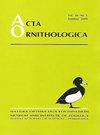在戴口罩的捕Gnatcatcher Polioptila dumicola中,随着树冠覆盖和蛛形纲动物改善巢生长,食物输送率增加
IF 1.3
4区 生物学
Q3 ORNITHOLOGY
引用次数: 6
摘要
摘要食物资源与栖息地特征有关,是制约鸟类生活史的最重要力量之一。食物的供应会影响鸟类的身体状况,并在很大程度上决定鸟类的繁殖性能。对于北半球的许多小型雀形目动物来说,鳞翅目幼虫(毛虫)和蛛形纲动物是饲养阶段的重要饮食成分,但新热带地区的信息很少。在这项研究中,我们评估了毛虫和蛛形纲动物雏鸟的食物输送率与食虫性蒙面Gnatcatcher Polioptila dumicola筑巢栖息地的树冠覆盖率和外来树木比例之间的关系。此外,由于毛虫和蛛形纲动物是雏鸟的优质猎物,我们还评估了这两种猎物的食物输送率差异是否与雏鸟的生长率有关。我们在2015-2018繁殖季节拍摄了阿根廷中东部原生森林中的23个巢穴。毛毛虫和蛛形纲动物的繁殖都与巢穴周围的树冠覆盖呈正相关。巢穴周围的外来树冠覆盖率较低(平均8.18%),与食物输送频率无关。蛛形纲动物的分娩比例与体重的渐进值和筑巢跗骨的最大生长率呈正相关。我们的研究结果证实,食物资源受到巢穴周围树冠覆盖的影响,这表明树木覆盖较少的森林可能会导致食物量的普遍减少。我们得出的结论是,不同树木覆盖程度的栖息地之间巢食的差异有助于解释该物种繁殖性能的差异。由于近几十年来这些森林的变化程度令人担忧,我们强调了保护树木覆盖率高的森林部分的重要性,以确保南方蒙面Gnatcatcher种群更好地筑巢生长。本文章由计算机程序翻译,如有差异,请以英文原文为准。
Food Delivery Rates Increased with Forest Canopy Cover and Nestling Growth Improved with Arachnids in the Masked Gnatcatcher Polioptila dumicola
Abstract. Food resources are linked to habitat characteristics and are one of the most important forces which constrain avian life histories. Availability of food affects avian body condition and strongly determines avian breeding performance. For many small passerines in the Northern Hemisphere, lepidopteran larvae (caterpillars) and arachnids are crucial dietary components during the rearing stage, but scarce information is available for Neotropical regions. In this study, we evaluated the relationship between the food delivery rates to the nestlings of caterpillars and arachnids and the tree-canopy cover and proportion of exotic trees of the nesting habitat of the insectivorous Masked Gnatcatcher Polioptila dumicola. In addition, as caterpillars and arachnids are high-quality prey-items for nestlings, we also evaluated whether differences in food delivery rates of these two prey-items were associated with nestlings' growth rates. We videotaped 23 nests in native forests of central-east Argentina during 2015–2018 breeding seasons. Both caterpillars and arachnids deliveries were positively associated with tree-canopy cover at the nest surroundings. Percentage of exotic tree-canopy cover in the nest surroundings was low (mean 8.18%), and was not associated with the frequency of food delivery. The proportion of arachnids delivered was positively associated with the asymptotic values of body mass and with the nestling tarsus maximum growth rate. Our results confirm that food resources are influenced by the tree-canopy cover in the nest surroundings, suggesting that less tree-covered patches of forests may contribute to a general decrease in the amount of food. We conclude that differences in nestling diet between habitats with different degree of tree cover contribute to explaining variance in the breeding performance of this species. Due to the alarming degree of alteration of these forests in recent decades, we highlight the importance of preserving forest portions with a high tree-cover that ensure better nestling growth in austral Masked Gnatcatcher's populations.
求助全文
通过发布文献求助,成功后即可免费获取论文全文。
去求助
来源期刊

Acta Ornithologica
生物-鸟类学
CiteScore
2.10
自引率
0.00%
发文量
14
审稿时长
>12 weeks
期刊介绍:
Publishes scientific papers (original research reports, reviews, short notes, etc.) and announcements from all fields of ornithology. All manuscripts are peer-reviewed.
Established in 1933 as Acta Ornithologica Musei Zoologici Polonici, since 1953 continued under the present title.
Published twice a year by the Natura Optima Dux Foundation under the auspices of the Museum and Institute of Zoology, Polish Academy of Sciences.
 求助内容:
求助内容: 应助结果提醒方式:
应助结果提醒方式:


